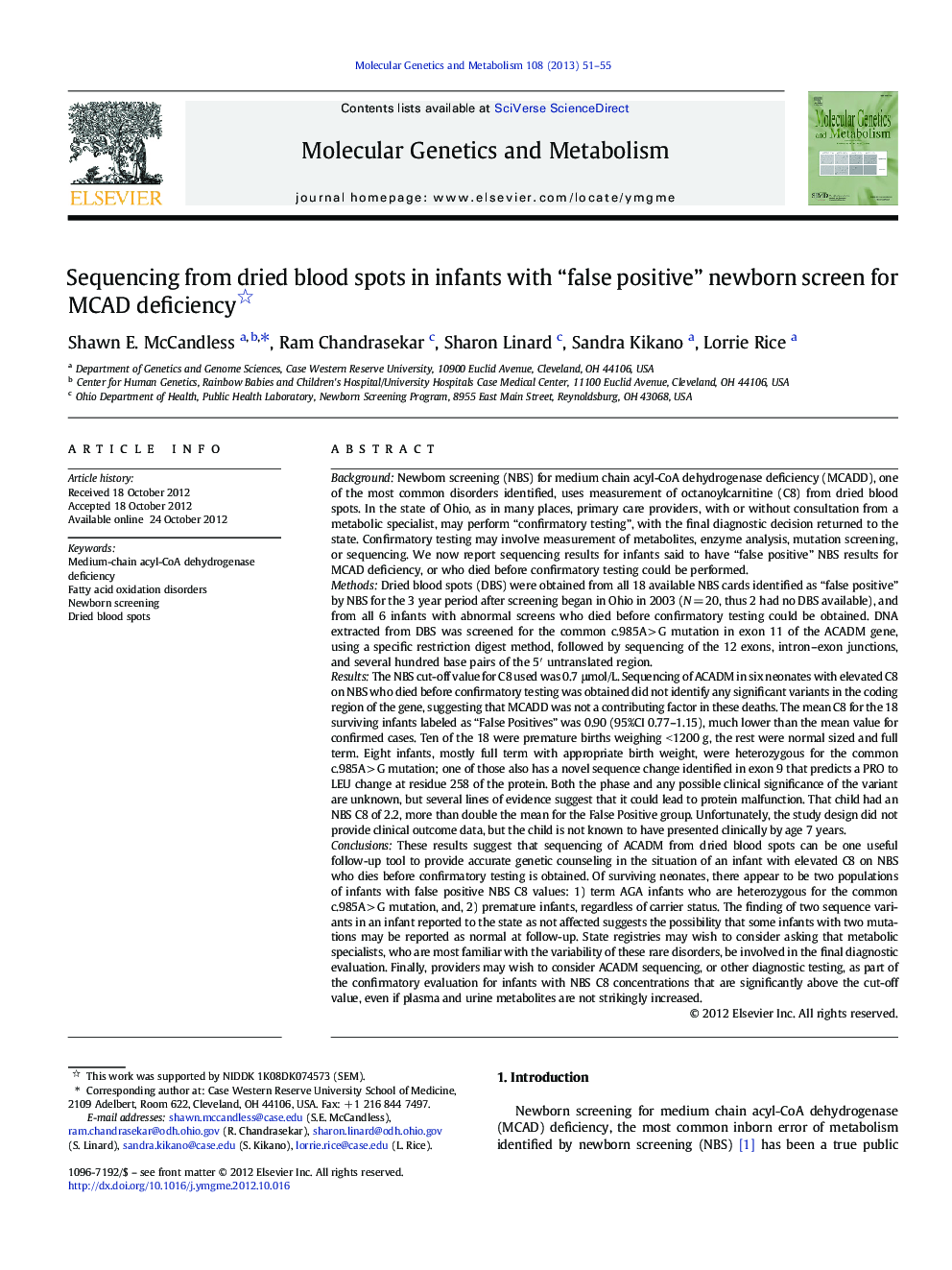| کد مقاله | کد نشریه | سال انتشار | مقاله انگلیسی | نسخه تمام متن |
|---|---|---|---|---|
| 1998722 | 1065819 | 2013 | 5 صفحه PDF | دانلود رایگان |

BackgroundNewborn screening (NBS) for medium chain acyl-CoA dehydrogenase deficiency (MCADD), one of the most common disorders identified, uses measurement of octanoylcarnitine (C8) from dried blood spots. In the state of Ohio, as in many places, primary care providers, with or without consultation from a metabolic specialist, may perform “confirmatory testing”, with the final diagnostic decision returned to the state. Confirmatory testing may involve measurement of metabolites, enzyme analysis, mutation screening, or sequencing. We now report sequencing results for infants said to have “false positive” NBS results for MCAD deficiency, or who died before confirmatory testing could be performed.MethodsDried blood spots (DBS) were obtained from all 18 available NBS cards identified as “false positive” by NBS for the 3 year period after screening began in Ohio in 2003 (N = 20, thus 2 had no DBS available), and from all 6 infants with abnormal screens who died before confirmatory testing could be obtained. DNA extracted from DBS was screened for the common c.985A > G mutation in exon 11 of the ACADM gene, using a specific restriction digest method, followed by sequencing of the 12 exons, intron–exon junctions, and several hundred base pairs of the 5′ untranslated region.ResultsThe NBS cut-off value for C8 used was 0.7 μmol/L. Sequencing of ACADM in six neonates with elevated C8 on NBS who died before confirmatory testing was obtained did not identify any significant variants in the coding region of the gene, suggesting that MCADD was not a contributing factor in these deaths. The mean C8 for the 18 surviving infants labeled as “False Positives” was 0.90 (95%CI 0.77–1.15), much lower than the mean value for confirmed cases. Ten of the 18 were premature births weighing < 1200 g, the rest were normal sized and full term. Eight infants, mostly full term with appropriate birth weight, were heterozygous for the common c.985A > G mutation; one of those also has a novel sequence change identified in exon 9 that predicts a PRO to LEU change at residue 258 of the protein. Both the phase and any possible clinical significance of the variant are unknown, but several lines of evidence suggest that it could lead to protein malfunction. That child had an NBS C8 of 2.2, more than double the mean for the False Positive group. Unfortunately, the study design did not provide clinical outcome data, but the child is not known to have presented clinically by age 7 years.ConclusionsThese results suggest that sequencing of ACADM from dried blood spots can be one useful follow-up tool to provide accurate genetic counseling in the situation of an infant with elevated C8 on NBS who dies before confirmatory testing is obtained. Of surviving neonates, there appear to be two populations of infants with false positive NBS C8 values: 1) term AGA infants who are heterozygous for the common c.985A > G mutation, and, 2) premature infants, regardless of carrier status. The finding of two sequence variants in an infant reported to the state as not affected suggests the possibility that some infants with two mutations may be reported as normal at follow-up. State registries may wish to consider asking that metabolic specialists, who are most familiar with the variability of these rare disorders, be involved in the final diagnostic evaluation. Finally, providers may wish to consider ACADM sequencing, or other diagnostic testing, as part of the confirmatory evaluation for infants with NBS C8 concentrations that are significantly above the cut-off value, even if plasma and urine metabolites are not strikingly increased.
► We sequenced the ACADM gene in infants with “false positive” NBS C8 values
► Slight increases above the C8 cut-off value identify carriers of the common 985A > G mutation in full-term AGA infants
► False positive results are also seen in non-carrier premature infants
► We identified 1 out of 18 cases diagnosed as “false positive” with 2 ACADM mutations, but phase could not be confirmed
► Final diagnosis following any NBS test requires correlation of all the available data to the clinical situation
Journal: Molecular Genetics and Metabolism - Volume 108, Issue 1, January 2013, Pages 51–55